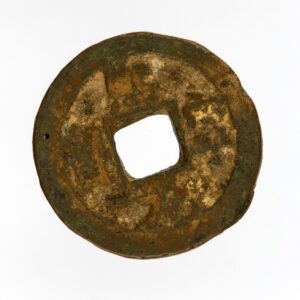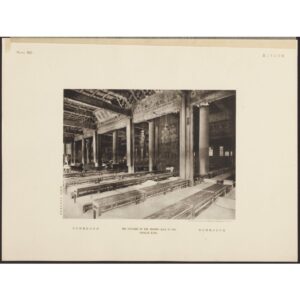Photography Railway Station and the City Walls
A black-and-white photograph showing the Beijing-Mukden railway station (now Shenyang 瀋陽). It stood by the southern wall, which separated the inner (Neicheng 内城) and outer (Outer City 外城) districts of Beijing. In addition to the Western-style main building and platforms, part of the outer district can be seen in front of the platforms, and the city wall stretches in the distance.
From Beijing, the railway ran in three directions: to the city of Hankou 漢口, to the city of Mukden, and to Suiyuan 綏遠 province (part of present-day Inner Mongolia). The station in the photo is the main station on the Beijing-Mukden route, also known to foreigners as the Eastern Station. The line that runs on this route today is called the Beijing-Haerbin Line 哈爾濱. It is the second oldest railway line in China and the oldest line still in operation. The beginnings of construction date back to 1881, and the extension to the city of Mukden was carried out in 1912. Opposite the station ... more
A black-and-white photograph showing the Beijing-Mukden railway station (now Shenyang 瀋陽). It stood by the southern wall, which separated the inner (Neicheng 内城) and outer (Outer City 外城) districts of Beijing. In addition to the Western-style main building and platforms, part of the outer district can be seen in front of the platforms, and the city wall stretches in the distance.
From Beijing, the railway ran in three directions: to the city of Hankou 漢口, to the city of Mukden, and to Suiyuan 綏遠 province (part of present-day Inner Mongolia). The station in the photo is the main station on the Beijing-Mukden route, also known to foreigners as the Eastern Station. The line that runs on this route today is called the Beijing-Haerbin Line 哈爾濱. It is the second oldest railway line in China and the oldest line still in operation. The beginnings of construction date back to 1881, and the extension to the city of Mukden was carried out in 1912. Opposite the station shown was the so-called West Station of the Beijing-Hankou line. Both were built on the main passage between the inner and outer quarters, that is, next to the Zhengyang Gate (Zhengyangmen 正陽門), better known as the Front Gate (Qianmen 前門).
Large-scale railway construction in China began in 1876, when the British built the first kilometres of railway in Shanghai. Between 1895 and 1912, the railway infrastructure was expanded by the granting of concessions to foreign companies. In addition to infrastructure, these companies were also granted concessions to manage companies established in 1904–1907 by provincial governments to operate the national railways, some of which soon went bankrupt. The Qing Dynasty government nationalised these companies and granted concessions to foreign banks in exchange for loans. This decision led to the Railway Protection Movement (Baolu Yundong 保路運動).
The photograph is the 106th of 449 photographs of Beijing and its surroundings in the album of Ivan Skušek Jr., purchased during his stay in Beijing (1914–1920). In the handwritten inventory of the album, the photograph is referred to as Bahnhof und Stadtmauer. (DZ, MV)



































Do you have a comment or additional information about the subject?